Monkeys are among the most common and diverse animals in the world. There are more than 200 species of monkeys, and they are found on every continent except Antarctica. They’re not only adorable and fun, but they also have a lot to teach us about ourselves.
Monkeys live in various habitats: forests, jungles, grasslands, deserts, and cities! Some monkeys live high in trees; others are ground dwellers or near water. You can find some monkeys that can swim underwater for extended periods (up to 20 minutes!), while others spend their time on land or in trees.
There are different kinds of monkeys in the world, each with unique characteristics and features. This article will discuss some of the most common types of monkeys found in various regions worldwide.
Overall, the world has some 200 species and types of monkeys when answering how many different types there are.
However, the species count was likely higher in ancient times when human development was less pronounced today. Some monkeys are as small as 4 ounces, while others weigh 77 pounds.
Physical anthropologists and biologists study various monkey breeds. They particularly study how types of monkeys diverged into 2 major groups today.
Common Knowledge Versus Science

Most people think of the creatures they see at the zoo with the mention of monkeys. Because many municipal facilities put these animals together in the same part of the zoo park, it’s straightforward for the average person to think they all come from the same area covered with jungles and trees.
The world’s monkey breeds fall into the Old World and New World. Old World monkeys come from Africa and Asia. They spend much time on the ground, although many species can climb if needed.
New World monkeys all come from Central and South America and are almost all tree-dwelling for most of their lives. They only come down to the ground for food or out of fear, trying to hide and find shelter.
New World monkeys do not have manual dexterity like Old World monkeys. The prehensile tail of the spider monkey is a good example of New World monkeys using other resources for grasping or support. Old World monkeys have thumbs that can be opposed to other fingers, enabling them to grip or grasp objects.
Physical Variation Separates Monkey Types
There are lots of physical differences in the list of monkeys living today. Old World monkeys have tails, but they cannot use them functionally. Another big distinction involves the tail. New World monkeys are very adept at climbing or hanging with their tails.
For example, Old World monkeys have opposable thumbs, much like humans. Compared to New World monkeys, those from the Old World have narrower noses with their nostrils pointing downward. Old World monkeys have fewer teeth and color vision.
However, their cross-ocean cousins do not. This diversity in the different breeds of monkeys shows great growth in the overall collection of monkeys worldwide, giving biologists plenty of issues to study. Here are some of the better-known species from both groups.
Types of Old World Monkeys
1. The Baboon

Long known on the plains of Africa, the Baboon has had a long history in mankind’s records, dating back as far as the ancient Egyptians at least. The baboon is a good example of an Old World monkey species. It is part of the Papio family and is a ground scavenger.
They are most common in the drier parts of Saudi Arabia and Africa. There are five different types, with the Mandrill being the largest.
Baboons are particularly aggressive, move in packs, tend to be omnivores, and have vicious sets of teeth and claws with thick fur as a defense.
Baboons are commonly found in savannahs, hills, and open woodlands. They are rarely found in jungles. Most of their diet tends to be insects, fruit, scavenging, small animals, small birds, and even fish when they get a chance.
Baboons have even been known to take down an antelope if possible, as they are voracious meat-eaters when the opportunity presents itself. The various Baboon species tend to run anywhere from 30 to 45 years of age, and they can learn skills and behavior.
Some in captivity have been taught to read. Any climate similar to a savannah will do, and a Baboon colony even thrives in Texas and all other places thanks to being transplanted.
The five species of baboons are the olive baboon, yellow baboon, hamadryas, or “holy” baboon, chacma baboon, and Guinea baboon.
Their long muzzles and hairless buttocks help them sit on the ground. Unfortunately, they are often considered a nuisance. They have frequent interactions with people. There has been a widespread decline in the population of many animal species. Discover how many elephants are still living in the wild.
The Olive Baboon

Olive baboons are so named because of their olive-colored coats and the huge manes that the males have over their heads and shoulders. Even though olive baboons don’t have prehensile tails, they are still capable tree climbers. Their tails look to be broken.
In groups of tens to hundreds, men and females of the olive baboon species compete for dominance. Males and females form deep bonds of friendship. When a male olive baboon sees his female buddies being threatened by other females, he may step in to defend them.
The olive baboon’s range extends from Africa to the Arabian Peninsula, where it is found in its native habitat. These Old World primates are among the planet’s most widely dispersed apes. Like other baboon species, they have plundered farmlands and can be quite hostile toward humans and other animals.
The Yellow Baboon

The Yellow Baboon lives in southern Ethiopia and extends south to northern Mozambique. These long-nosed baboons are a golden brown color. They also have silvery-colored fringes on their hands and feet.
Compared to the average female weight of 12 kilograms, males are greater at roughly 23 kilograms. Yellow baboons spend much of their time on the ground, where they can forage, build their nests, and interact with other individuals. They are primarily herbivores but consume leaves, flowers, buds, pods, grass, fruit, seeds, roots, insects, and meat.
They have a complex social structure, with anywhere from 20 to 180 members in a single troop. To convey meaning, they use a repertoire of over 10 vocalizations and gestures.
Their complex social structure has 20 to 180 members in a single troop. They use a repertoire of over 10 vocalizations and gestures to convey meaning. To increase their chances of mating, males will create “friendships” with females in the flock and defend them from rival males. Women of varying ages show different degrees of maternal affection for their infants. They do this by nursing, grooming, and playing with them.
The Hamadryas or “Sacred” Baboon
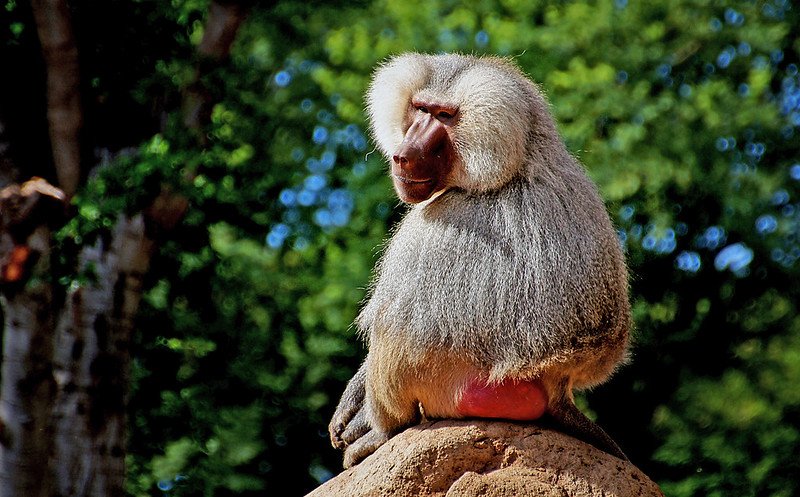
The hamadryas baboon is a member of the Old World monkey family. Its natural habitats include the Horn of Africa and the southwestern part of the Arabian Peninsula, making it the most northern baboon species.
There are fewer natural predators in these areas compared to central and southern Africa, where other baboons live. One of the names for the hamadryas baboon is “holy baboon” because of the animal’s prominence in ancient Egyptian religion.
The Hamadryas baboon is a species of Old World monkey known for its strength and size. They are exceptionally smart creatures. The silver manes and pink faces of mature males of this species are easily recognizable characteristics.
In ancient Egypt, they were worshiped as messengers of Thoth, the Egyptian deity of knowledge. That’s why people sometimes refer to them as “Sacred baboons.” These creatures are now only present in Ethiopia, Somalia, Saudi Arabia, and Yemen but were once widespread throughout Egypt. The natural range of the Hamadryas baboon is the farthest north of all baboon species. Large groups of these primates, numbering in the hundreds, have been observed.
Hamadryas baboons are nocturnal in their habits and prefer to sleep throughout the day. They are terrestrial but favor sleeping in trees or on cliffs. The social structure of these monkeys is quite intricate, with males actively herding and controlling groups of anything from one to nine females and their young.
They form tight-knit groups called “clans.” A subordinate “follower” male, usually linked to the dominant male, is also present in each group. Group members rest, move about, and eat as a unit. Occasionally, groups will come together to create bands. Hamadryas baboons often congregate in large groups called troops, numbering several hundred strong.
The Hamadryas baboon is an omnivore, meaning that it eats both plant and animal matter. It mostly subsists on fruit, tree gums, acacia seeds, acacia blossoms, seeds, grass, rhizomes, corms, roots, tubers, tiny vertebrates, insects, and eggs.
See Related: Fun, Interesting Facts About Whales
Chacma Baboon

Of the five different types of baboons, the chacma baboon, also known as the Cape baboon, is the largest. You can find baboons in the drier parts of Africa, which are huge monkeys. The chacma baboon, Papio ursinus, is its official scientific moniker.
The vast majority of the world’s baboon population is found in Africa. Most Chacma baboons may be found south of the Zambezi River. Their favorite habitats are grasslands and semiarid regions. South Africans can be found everywhere, from the highlands to the seaside.
Unlike chimpanzees, chacma baboons have longer faces and pointier teeth. They have a somewhat close-set pair of eyes. The average length of a baboon’s curled tail is around 30 inches. Adult male chacmas typically tip the scales at around 30 kg. Men are twice as big as women. They have dark gray to brown hair. The tails of Chacmas are held high when they walk on all fours.
Chacma baboons, like all baboons, are omnivores. Because of this, they consume a wide variety of foods, including vegetation, fruit, rodents, and birds. Farmers report that these creatures occasionally snack on their crops. They spend most of the day on the ground, lying in trees or rocks. The chacma is a highly sociable mammal. They have a sophisticated social hierarchy within their troop.
Guinea Baboon

The Guinea Baboon is a primate native to Africa. It spends most of its time on the floor, sleeping in tall trees, yet can walk up to eight kilometers on its own two feet.
The Guinea Baboon spends the night in large groups (40-100 individuals) up in the trees or on steep slopes to avoid predators. When the sun rises, they form smaller groups called harems and descend to the ground to forage for food. Farmers frequently hunt or poison them because they readily feed in the fields. They use a variety of non-vocal cues to convey meaning to one another, including eye blinks, ear- and lip movements, yawning, and staring. In addition to its “cleaning” function, baboons use grooming to strengthen emotional relationships with one another. To the extent of creating grooming groups, they engage in mutual grooming as their affection for one another grows.
The groupings adhere to a rigid hierarchical structure. A male will have anything from one to four females under his command and be ranked among the other men in his harem. As a result, gatherings of people can display incredibly nuanced patterns of social interaction. A girl may stay with her family and eventually take on her mother’s social responsibilities. Once a boy reaches puberty, he typically moves on from his family and joins a different group.
The Guinea baboon is the smallest of the five different baboon species. The muzzle of its hairless, pitch-black face is extended like that of a dog. Males are larger and taller than females, and their canines can be up to 5 cm longer. Its fur, especially around the neck and shoulders, is thicker and denser than a female’s.
During the breeding season, male baboons may recognize the females by the red, swollen buttocks that signal mating.
See Related: Interesting Examples of Habitats
2. The Macaque

Macaques are a sort of monkey found in Asia and Africa; they are the ones you could have seen relaxing in snowy Japan’s natural hot springs. Macaques, in an interesting fact about animals that you probably didn’t know, are adept pickpockets.
There are 23 different species, and they all provide something special. Scientists are only just beginning to scratch the surface of the intricate social behaviors of Tibetan macaques, but they are vibrant, boisterous, and incredibly social.
In what scientists call “bridging” behavior, infants are employed as a social tool between adults in social interactions, as seen in Tibetan macaques and other species. One will pick up a baby and carry it to another, where they will hold it and talk to or kiss the child’s privates. Not knowing the full explanation for this phenomenon is frustrating, but it is fascinating.
The Rhesus Macaque

Referred to as the Rhesus for short, the Rhesus Macaque looks a bit like a white fur cousin of a Baboon on facial inspection. This type of monkey is a ground-dwelling Old World species with a wide range and lives about 25 years.
Rhesus can be found as far east as China and south as India. Many people have encountered them traveling in those regions. However, because some were taken as pets, they have exploded in number as an invasive species in Florida, of all places.
The species has been well-known in the scientific world because its DNA is very similar to that of humans.
However, it’s also a potential risk incubator for new viruses that can cross over and affect humans, so biologists and virology scientists spend a lot of time tracking the species, particularly in Asia, to ensure it doesn’t create a new viral outbreak.
See Related: Malayan Tiger
The Japanese Macaque
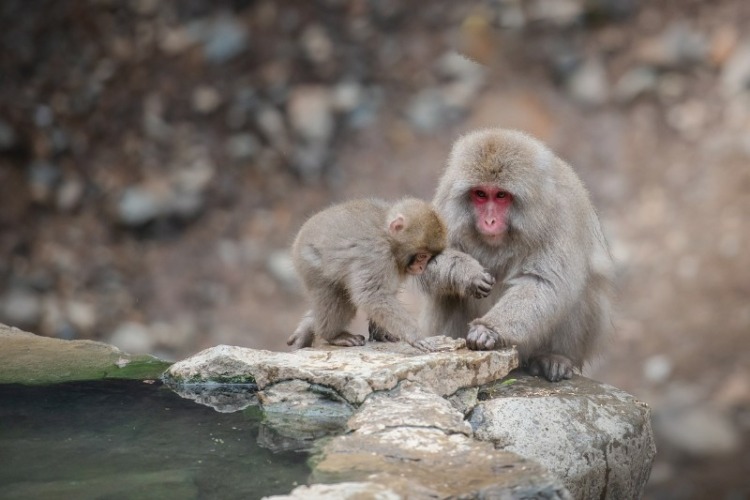
Probably most famous for being the hot spa sitting monkey in snowy winter, these monkeys are native to Japan and tend to be found in the mountain areas of the Asian islands.
Like the photos of them in the wild, they enjoy sitting in hot natural geothermal waters in winter, and their thick fur makes them look like monkeys wearing parkas in the snow.
The Japanese Macaque has been a regular neighbor of Buddhist temples in Japan and is frequently compared to other types of monkeys in the country’s religious history and lore.
3. The Guenon Monkey

According to the Smithsonian National Zoo in Washington, DC, guenons are the most numerous and diversified African primates, with 26 species. Their long tails assist them in balance, which contributes to their graceful demeanor and vibrant fur patterns.
The Allen’s swamp monkey is one of Alm’s favorite species of monkey, and it is commonly lumped in with guenons. As its name suggests, this monkey likes to hang around in the water. A unique trait of Allen’s swamp monkeys is the tiny skin webbing between their fingers and toes, which helps them swim to forage or avoid predators.
4. The Mandrill Monkey

Unlike its smaller cousins, the Mandrill definitely likes to inhabit wet jungles and deeper Africa. This species can be found in the Congo, Cameroon, and Gabon.
They also move around in large groups, finding protection in numbers. They eat bugs, plants, and anything small enough to catch.
The species is famous and tends to represent all Baboons because of their colorful flared faces and hindquarters on the males.
See Related: African Elephant
5. The Colobus Monkey
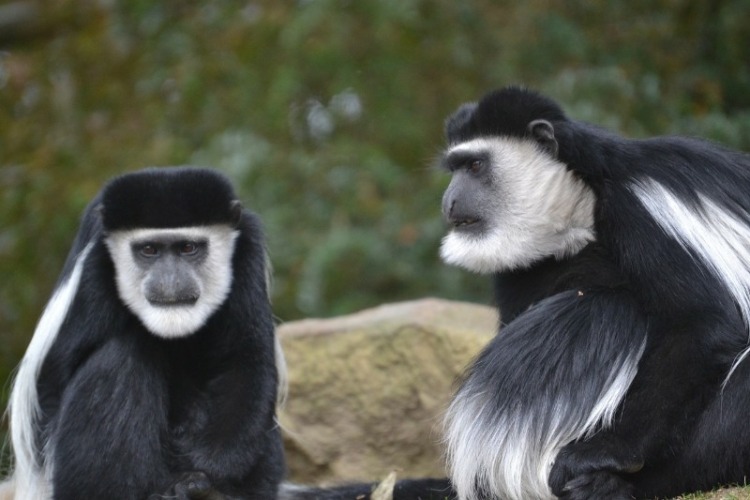
Colobus and Asian monkeys are similar in many ways, including their digestive systems adapted to a diet of leaves. Despite this, they make their home among the trees of Africa.
The Zanzibar red colobus, a species unique to the island of Zanzibar, has brilliant red, black, and white coats and lovely tufts of white hair around its face. It is in perilous straits.
He explains that baby members of this leaf-eating monkey species are born completely white, making them easily identifiable. The rationale is that they are easily spotted and located by the family unit up in the thickly forested trees. Adults of this species have long white hair on their backs, whitetails, and black and white facial fur.
6. Mangabeys

Although all 13 species of these African monkeys share a common ancestor, they are easily distinguishable by their white eyelids. A dark mahogany “cap” can be seen atop the heads of red-capped mangabeys, a species of ape native to West Africa.
Because of their ‘fission-fusion’ social structure, they can break into smaller communities inside the larger one rather than being a monolithic society. One unfortunate wild animal that has become “endangered” in 2019 is the red-capped mangabey, which was previously listed as “threatened” on the International Union for the Conservation of Nature’s Red List.
7. Langurs
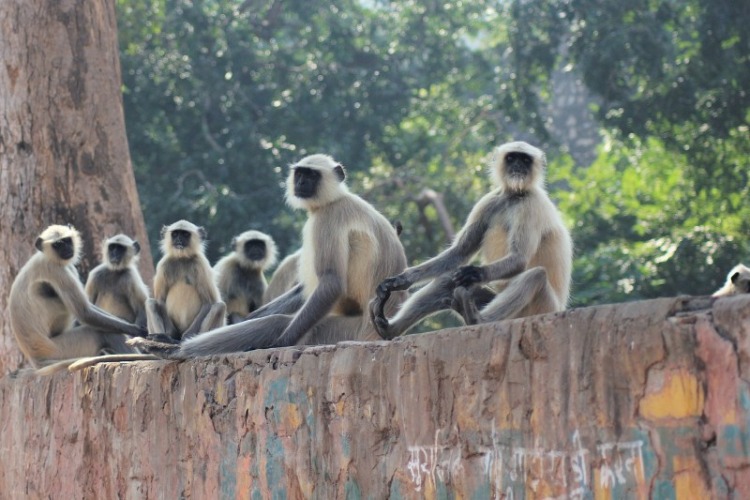
The word “langur” describes numerous species of leaf-eating, tree-dwelling monkeys native to Asia. At least 28 species of langurs and related monkeys, such as lutungs, doucs, and surilis.
Many of these creatures have facial hair arranged in tufts that are white, black, red, gray, or brown and stand up like trolls in cartoons. All adult silvery langurs are a uniform silvery grey, but newborns are a vibrant orange that attracts females to assist in caring for the young.
They are one of the species whose adult appearance differs greatly from that depicted in prenatal photographs.
8. The Proboscis Monkey

Like something from a bad cartoonist’s joke, the Proboscis monkey has a very noticeable and ugly-looking nasal feature not found in other types of monkeys.
Technically titled long-nosed, the species is from the Old World monkey family and is most commonly found in Southeast Asia, particularly in Borneo. They are not aggressive and are frequently found in the same tree locations as Orangutans.
Size-wise, the Proboscis monkey is the largest monkey type in Asia among all the species in the region. They can reach up to 76 cm in length and typically weigh as much as 12 kilograms. The noses, which tend to hang off the face, look comical, along with the animal’s pot belly.
As a group, the females take charge and generally hold titles or create their groups as breakaways from their prior, early pack.
See Related: Przewalski’s Horse
9. The Vervet Monkey

A grey, white fur monkey native to Africa, these Old World monkeys roam the ground and stones regularly, looking for whatever might be edible. Fruit and bugs are high on the menu, but they have no problem stealing interesting human food given the chance to do so.
They mostly appear in Southern Africa and live in small packs. The adults have a black face and tail, while the rest of the body is covered in lighter fur.
Finding homes in small bushes and trees, they are fast scramblers and scavenge just about anything interesting on the ground, always looking for another meal.
These monkeys were regularly used as lab animals in the 1950s and 1960s, and a close examination of black-and-white documentary films of psychology experiments will show that many subjects were baby Vervets.
See Related: Asian Lion
Types of New World Monkeys
1. The Capuchin Monkey

From the monkey Cebinae family, the Capuchin is a New World monkey that is most recognizable as the monkey the pirate, streetcorner peddler, or circus musician has for a pet. According to Hollywood, this little fellow is quite gregarious, big on showing its mouth, and likes to take off with shiny things.
The species has been prized as a pet, but having or trying to domesticate can be painful. These types of monkeys are extremely messy, fussy, and downright aggressive. It takes a considerable amount of training just to have them around humans without someone getting bit or scratched.
In terms of their natural home, Capuchin monkeys have a wide range, being found in both Central and South America, and they tend to favor lower wetlands versus the mountainous areas. They are also quite fond of the coastal areas where the temperature tends to be lower from the midday heat.
Surprisingly, some versions of the Capuchin favor the drier inland parts on the Pacific side, with plenty of forests to hide in.
The blond Capuchin is the world’s most endangered monkey and is considered a critically endangered species. Only an estimated 180 mature individuals are in the wild, and these small monkeys are only found in the coastal rainforests of northeastern Brazil.
See Related: Amur Leopard
2. The Marmoset
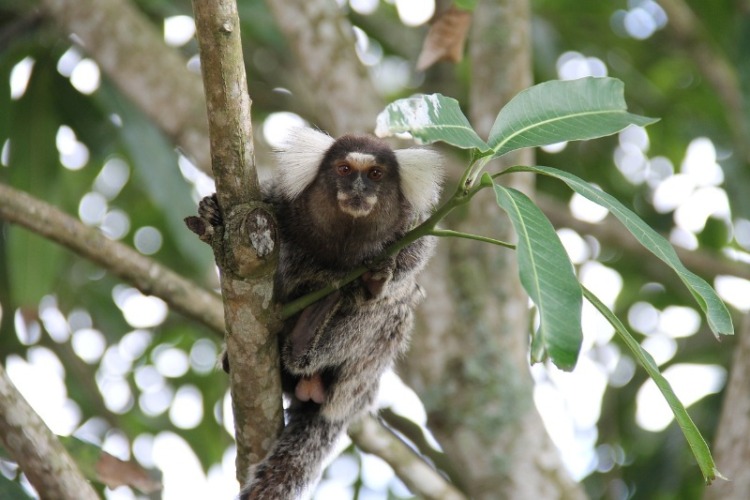
In the New World, this species is also known as the Zaris. Small in size, they only reach about eight inches in height at full adulthood. They are extremely good climbers and use claws and very grabby or tactile hair on their wrists to hold onto things.
No surprise, tree-dwelling is part of their life, and the marmoset is rarely found on the ground. Marmosets tend to be restricted to South America, and many locals have them as pets in the rural parts of the region.
They are extremely active at night, chasing insects for a diet bonus when not feasting on fruit plant leaves.
3. The Tamarin Monkey

Also, a small monkey species from the New World, these animals are part of the Callitrichidae family. They are most recognizable by a facial hair feature that makes them look like they have an extended mustache from the 1800s.
They get to be about 13 to 30 centimeters in length as adults and also find the Central and South American jungles as home. Easily eating anything in sight smaller than them, Tamarins are omnivores, gobbling up bugs, fruit, amphibians, and even bird eggs given a chance.
See Related: King Cobra
The Golden Lion Tamarin

A related species to the monkey breeds above, The Lion Tamarin appears with bright orange-gold fur and is considered a New World monkey species.
They tend to be bigger, averaging 30 cm long and weighing far more. Using both fingers and claws, they are quite adept at moving around on branches and digging out insects for food.
They supplement their insect diet with fruit, small amphibians, and lizards, and they even go after snakes when possible.
Lion Tamarins are extremely rare, however, and appear on endangered species lists in multiple countries. Diminishing habitats in tropical and subtropical forests have decimated this endangered species.
See Related: Habitat Loss Solutions You Need to Know
4. The Spider Monkey
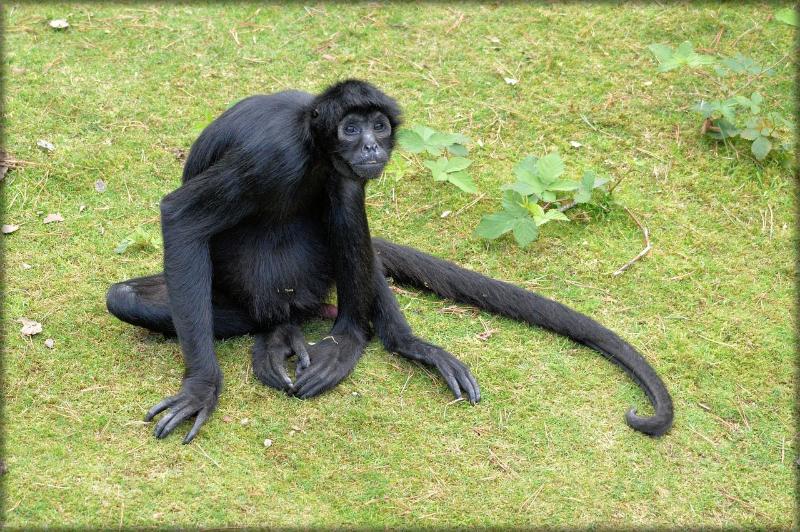
A wonder of the New World monkeys, this type of monkey is a flying marvel of the high part of jungles in South and Central America. Its arms and legs are matched by an extra long tail, and the species spends an incredible amount of time hanging upside down on a normal day of activities.
This New World monkey was dubbed its name because they have an amazing ability to climb. These creatures easily swing and jump, defying gravity and rarely touching the ground.
The Central American spider monkey (Ateles geoffroyi) is also known as the black-handed spider monkey and Geoffroy’s spider monkey. These long-limbed monkeys, which may reach up to three feet long, are recognized for their great agility.
See Related: Arabian Oryx
Primates you might have thought are monkeys.
Plenty of other animals out there look like monkeys but aren’t monkeys. Many of the primates that you’ve probably thought were monkeys are apes—and some are even closer to humans than they are to other apes.
Chimpanzees

Unlike Hollywood’s depiction, the common “monkey” most people are familiar with, the Chimpanzee, is not a monkey. Surprise! Chimpanzees are actually apes. Even in captivity, chimpanzees tend to be too aggressive and dangerous; Bonobos are what Hollywood uses, calling them chimpanzees in various scripts.
The Chimpanzee is indigenous to the jungles of Africa and is regularly found in regions like the Congo. They tend to live in packs of 15 to 20, and they are very territorial, competing with other packs for food and roaming grounds. Any disputes within the group and outside are often handled with violence.
Chimpanzees are officially an endangered species, only hitting a maximum of 300,000 worldwide. In recent years Chimpanzees have gained a significant amount of notoriety. Captive specimens attack their caretakers or escape and attack other people. Despite their size, Chimpanzees are incredibly strong. They are quite capable of overpowering humans.
Gibbons

Gibbons are small, but they are not monkeys. Gibbons are actually small apes. The Gibbon spends most of its time in the trees, flying from branch to branch. Gibbons have a wide range of territory regarding where they are found, from Southern China southward to Indonesia and as far west as northern India.
While gibbons spend a lot of time in the trees, they can quickly move on the ground and even walk on their hind feet. Even before being seen, Gibbon’s most notable feature is their voice.
Their hoot is loud and can be heard up to a mile away. Development and deforestation are their biggest enemy and threats, making Gibbons endangered.
See Related: Congo Peafowl
FAQ
What are the types of monkeys?
There are many types of monkeys, but the five most popular types are the spider monkey, the capuchin monkey, the lion monkey, the howler monkey, and the Barbary macaque. These five breeds of monkeys are some of the most widespread and recognizable worldwide. Each has unique characteristics that make it stand out from the rest.
How do Old World monkeys differ from New World monkeys?
Monkeys from the Old World have tails but can’t use them. The tail is another distinguishing feature. New World monkeys can climb or hang with their tails. Like humans, Old World monkeys have opposable thumbs. Old World monkeys have narrower, downward-pointing noses than New World ones. Old World monkeys have fewer teeth and color vision.
Are Gibbons Old World monkeys?
No. Gibbons are small apes.
What is the most common monkey?
The most common monkey is the macaque. Macaques are known for their distinctive facial features, including pronounced eyebrows and cheek whiskers. They can be found throughout Asia and North Africa and are known for their social behavior and intelligence.
Related Resources
